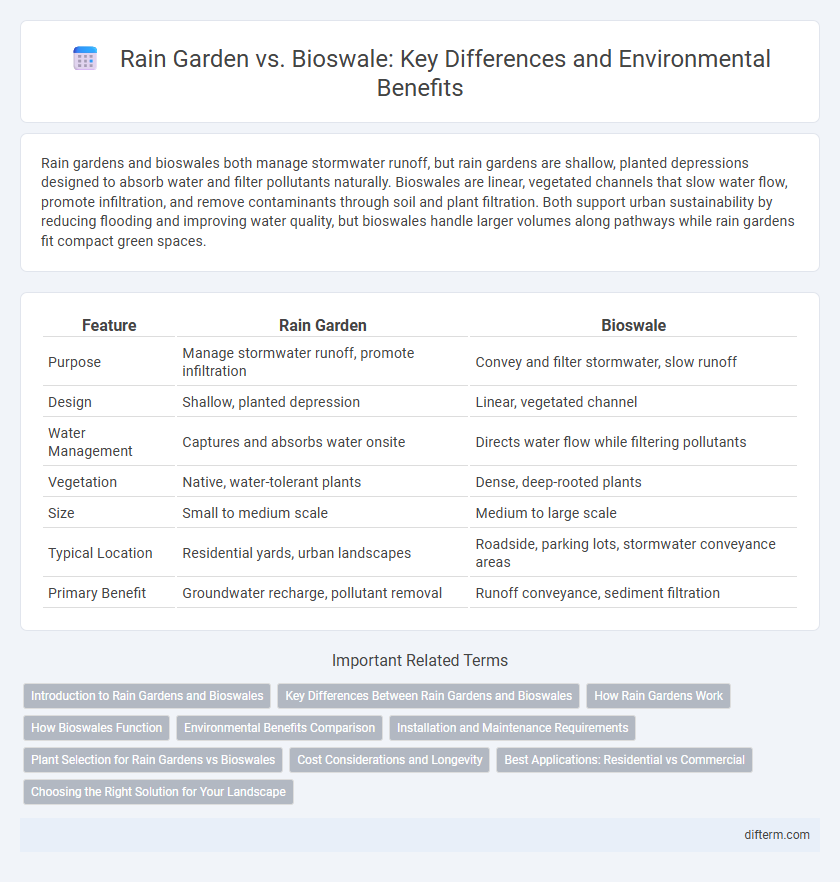Rain gardens and bioswales both manage stormwater runoff, but rain gardens are shallow, planted depressions designed to absorb water and filter pollutants naturally. Bioswales are linear, vegetated channels that slow water flow, promote infiltration, and remove contaminants through soil and plant filtration. Both support urban sustainability by reducing flooding and improving water quality, but bioswales handle larger volumes along pathways while rain gardens fit compact green spaces.
Table of Comparison
| Feature | Rain Garden | Bioswale |
|---|---|---|
| Purpose | Manage stormwater runoff, promote infiltration | Convey and filter stormwater, slow runoff |
| Design | Shallow, planted depression | Linear, vegetated channel |
| Water Management | Captures and absorbs water onsite | Directs water flow while filtering pollutants |
| Vegetation | Native, water-tolerant plants | Dense, deep-rooted plants |
| Size | Small to medium scale | Medium to large scale |
| Typical Location | Residential yards, urban landscapes | Roadside, parking lots, stormwater conveyance areas |
| Primary Benefit | Groundwater recharge, pollutant removal | Runoff conveyance, sediment filtration |
Introduction to Rain Gardens and Bioswales
Rain gardens and bioswales are sustainable stormwater management systems designed to reduce runoff and improve water quality by mimicking natural hydrology. Rain gardens are shallow, vegetated basins that capture and infiltrate rainwater from impervious surfaces, promoting groundwater recharge. Bioswales are linear, vegetated channels that filter and convey stormwater, slowing flow and trapping pollutants before water reaches storm drains or natural waterways.
Key Differences Between Rain Gardens and Bioswales
Rain gardens are shallow, planted depressions designed to capture and infiltrate runoff primarily from rooftops and small surface areas, enhancing groundwater recharge. Bioswales are linear, vegetated channels engineered to convey stormwater while filtering pollutants through extended flow paths and sedimentation. Unlike rain gardens, bioswales often handle larger volumes of water and are integrated into streetscapes or parking lots for stormwater management.
How Rain Gardens Work
Rain gardens function by capturing and infiltrating stormwater runoff through engineered soil layers and native vegetation, which filter pollutants and reduce surface runoff volume. These shallow, planted depressions retain water temporarily, allowing it to slowly percolate into the ground, thus recharging groundwater supplies. The combination of permeable soils and plant root systems enhances soil moisture retention while mitigating urban flooding and improving water quality.
How Bioswales Function
Bioswales function as engineered landscape elements designed to manage stormwater by directing runoff through vegetated channels that filter pollutants and promote infiltration. Their structure includes an elongated, shallow depression lined with native plants and permeable soil that slows water flow, allowing sediment and contaminants to settle naturally. This process reduces urban flooding, improves water quality, and replenishes groundwater sustainably.
Environmental Benefits Comparison
Rain gardens and bioswales both improve stormwater management by filtering pollutants and reducing runoff volume, benefiting urban water quality and ecosystems. Rain gardens enhance groundwater recharge through deep soil infiltration, while bioswales more effectively convey and treat larger stormwater flows along vegetation-lined channels. Both promote biodiversity, but bioswales provide greater habitat connectivity along streetscapes, contributing to urban ecological health.
Installation and Maintenance Requirements
Rain gardens require careful soil preparation and native plant selection to ensure effective water absorption and pollutant filtration, generally demanding moderate maintenance such as seasonal weeding and mulching. Bioswales involve excavating linear channels with engineered soil layers and vegetation designed for high water flow, necessitating more intensive upkeep including sediment removal and erosion control measures to maintain hydraulic efficiency. Both systems promote stormwater management but differ significantly in installation complexity and routine care.
Plant Selection for Rain Gardens vs Bioswales
Rain gardens typically feature native perennials and wildflowers such as coneflowers, black-eyed susans, and sedges that thrive in both wet and dry conditions, enhancing biodiversity and facilitating water absorption. Bioswales prioritize hardy, moisture-tolerant grasses and rushes like blue joint grass and soft rush that can withstand periodic flooding and help filter pollutants effectively. Selecting the right plants based on soil moisture, pollutant load, and local climate optimizes the functional efficiency of rain gardens and bioswales in stormwater management.
Cost Considerations and Longevity
Rain gardens typically have lower installation and maintenance costs compared to bioswales due to their simpler design and smaller scale, making them a cost-effective option for homeowners and small properties. Bioswales, while more expensive upfront because of their larger size and engineered components, offer greater durability and longevity, often lasting several decades with proper maintenance by municipalities or commercial properties. Both systems provide valuable stormwater management benefits, but selecting between them depends on budget constraints and long-term site planning priorities.
Best Applications: Residential vs Commercial
Rain gardens are best suited for residential areas where small-scale water management is needed to reduce runoff and improve groundwater recharge. Bioswales are more effective in commercial or urban settings due to their ability to handle larger volumes of stormwater and filter pollutants from extensive impervious surfaces. Choosing between a rain garden and a bioswale depends on site size, runoff volume, and specific environmental goals.
Choosing the Right Solution for Your Landscape
Rain gardens and bioswales both manage stormwater efficiently, but selecting the right solution depends on your landscape's size, slope, and drainage needs. Rain gardens are ideal for smaller areas with moderate slopes, featuring deep soil beds and native plants that absorb runoff. Bioswales suit larger, linear spaces with steeper gradients, utilizing vegetated channels to filter pollutants and direct water flow effectively.
Rain garden vs Bioswale Infographic

 difterm.com
difterm.com